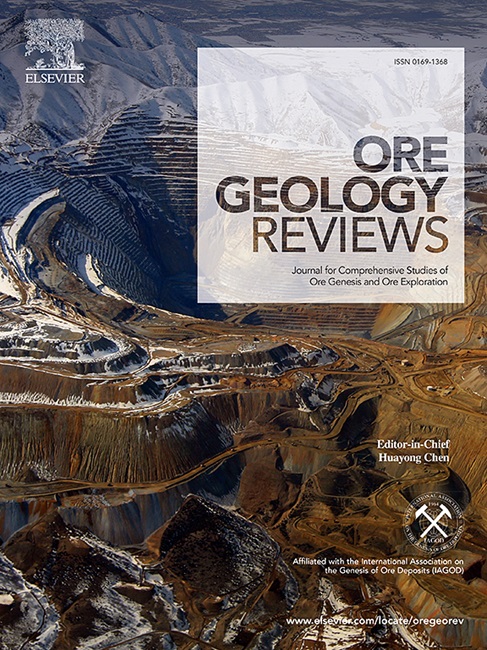Magmatic-hydrothermal processes forming the Meishan iron oxide-apatite deposit in the Ningwu volcanic basin (Eastern China): Insights from trace element and Fe-O isotope data of magnetite
IF 3.2
2区 地球科学
Q1 GEOLOGY
引用次数: 0
Abstract
Iron oxide-apatite (IOA) deposits are an important source for Fe that is variably accompanied by other elements such as P, Co, and REE. Still, their origin remains enigmatic, with existing models highlighting the role of magmatic, liquid immiscibility, magmatic hydrothermal processes, or a combination of those processes. Here we present new trace element and Fe-O isotope data of magnetite from the Meishan IOA deposit (338Mt iron-oxide ores) in Eastern China to further constrain the ore genesis. The Meishan deposit consists of disseminated, massive, and vein-type iron ores that are hosted within the Early Cretaceous andesitic rocks and, less significantly, in a coeval porphyritic gabbro-diorite intrusion. Petrographic and textural studies reveal six types of magnetite from the gabbro-diorite porphyry and various types of iron ores, and many of them show dissolution-reprecipitation textures. Trace element concentrations of magnetite, notably Ti, Al, Ga, and V, progressively decrease upwards, indicating a cooling trend likely from magmatic to hydrothermal conditions. A similar decreasing trend is also observed from magmatic magnetite in the ore-hosting rocks through massive and brecciated to the vein-type ores. Magnetite from the vein-type ores has δ56Fe values of 0.14–0.41 ‰ and δ18O values of 4.38–5.53 ‰, which are similar to those for the gabbro-diorite porphyry (0.25–0.36 ‰ and 3.77–4.62 ‰) and for the massive ores (0.16–0.19 ‰ and 3.41–5.70 ‰), respectively. The above textural, elemental, and isotopic evidence indicate that the Meishan IOA deposit is of magmatic-hydrothermal origin and records repeated vents of hydrothermal fluids.

宁武火山盆地梅山氧化铁磷灰石矿床形成的岩浆-热液过程:磁铁矿微量元素和铁氧同位素数据的启示
氧化铁磷灰石(IOA)矿床是铁的重要来源,并伴有P、Co、REE等其它元素。尽管如此,它们的起源仍然是个谜,现有的模型强调了岩浆、液体不混溶、岩浆热液过程或这些过程的组合的作用。本文对中国东部梅山IOA矿床(338Mt氧化铁矿石)磁铁矿进行了新的微量元素和Fe-O同位素分析,进一步对矿床成因进行了限定。梅山矿床由浸染状、块状和脉状铁矿组成,赋存于早白垩世安山岩中,也赋存于同时期的斑岩辉长闪长岩体中。通过岩石学和结构学研究,发现辉长闪长斑岩中有6种类型的磁铁矿和多种类型的铁矿石,其中许多具有溶蚀-再沉淀结构。磁铁矿中微量元素的浓度以Ti、Al、Ga、V为主,呈逐渐下降趋势,表明从岩浆到热液的冷却趋势。从含矿岩中的岩浆磁铁矿经块状、角砾岩到脉状矿石也有类似的递减趋势。脉状矿石中磁铁矿的δ56Fe值为0.14 ~ 0.41‰,δ18O值为4.38 ~ 5.53‰,与辉长闪长斑岩(0.25 ~ 0.36‰、3.77 ~ 4.62‰)和块状矿石(0.16 ~ 0.19‰、3.41 ~ 5.70‰)相似。上述结构、元素和同位素证据表明,梅山IOA矿床为岩浆热液矿床,并记录了热液流体的反复喷口。
本文章由计算机程序翻译,如有差异,请以英文原文为准。
求助全文
约1分钟内获得全文
求助全文
来源期刊

Ore Geology Reviews
地学-地质学
CiteScore
6.50
自引率
27.30%
发文量
546
审稿时长
22.9 weeks
期刊介绍:
Ore Geology Reviews aims to familiarize all earth scientists with recent advances in a number of interconnected disciplines related to the study of, and search for, ore deposits. The reviews range from brief to longer contributions, but the journal preferentially publishes manuscripts that fill the niche between the commonly shorter journal articles and the comprehensive book coverages, and thus has a special appeal to many authors and readers.
 求助内容:
求助内容: 应助结果提醒方式:
应助结果提醒方式:


